Properties and Microstructure Evaluation in NiAl-xWC (x = 0 − 90 wt.%) Intermetallic-Based Composites Prepared by Mechanical Alloying
Abstract
:1. Introduction
2. Materials and Methods
2.1. Sample Preparation
2.2. Material Characterizations
- Mechanically alloyed powders:
- NiAl—ref. code 01-083-3994
- WC—ref. code 00-025-1047
- W2C—ref. code 01-079-5801
- Sintered specimens:
- NiAl—ref. code 04-005-7098
- WC—ref. code 04-016-4756
- Rwp—weighted pattern residual indicator
- Rexp—expected residual indicator
- GOF—the goodness of fit
3. Results and Discussion
3.1. Structural and Morphological Powder Analysis
3.1.1. Synthesis of the Intermetallic NiAl matrix
3.1.2. Synthesis of NiAl-WC Composite Systems
3.2. Structural and Microstructural Analysis of Bulk Composites
3.3. Hardness and Density of NiAl-WC Composites
4. Conclusions
- -
- The mechanical alloying process allows the synthesis of intermetallic phase from pure Al and Ni elements. After 5 h of milling, a new phase appeared in composition;
- -
- The addition of WC phase did not affect the formation of NiAl intermetallic phase;
- -
- The addition of WC increased the intensity of the milling process respective to the analyzed structure strain level;
- -
- After the hot-pressing process, the phase composition of composites consists of NiAl and WC phases;
- -
- The reinforcing phase amount and final structure properties strongly depend on the initial composition, its structural state and applied sintering conditions influencing the dominative reinforcement mechanism;
- -
- The microstructure of the obtained composites shows an ultrafine-grain range;
- -
- The composites are characterized by elevated hardness, which reached 1800 HV for sample 90–1100.
Author Contributions
Funding
Informed Consent Statement
Data Availability Statement
Conflicts of Interest
References
- Camagu, S.T.; Mathabathe, N.M.; Motaung, D.E.; Muller, T.F.G.; Arendse, C.J.; Bolokang, A.S. Investigation into the thermal behaviour of the B2–NiAl intermetallic alloy produced by compaction and sintering of the elemental Ni and Al powders. Vacuum 2019, 169, 108919. [Google Scholar] [CrossRef]
- Deevi, S.C.; Sikka, V.K.; Liu, C.T. Processing, properties, and applications of nickel and iron aluminides. Prog. Mater. Sci. 1997, 42, 177–192. [Google Scholar] [CrossRef]
- Vedula, K.; Pathare, V.; Aslanidis, I.; Titran, R.H. Alloys based on Nial for high temperature applications. Mater. Res. Soc. Symp. Proc. 1985, 39, 411–421. [Google Scholar] [CrossRef] [Green Version]
- Yan, S.R.; Mehrizi, M.Z.; Foong, L.K. Synthesis of NiAl-WC composite by the thermal explosion of elemental powders. Ceram. Int. 2020, 46, 15146–15151. [Google Scholar] [CrossRef]
- Yuan, J.; Zhang, X.; Li, B.; Wang, X.; Sun, K. Microstructure and tribological behavior of NiAl/WC composites fabricated by thermal explosion reaction at 800 °C. J. Alloys Compd. 2017, 693, 70–75. [Google Scholar] [CrossRef]
- He, L.; Tan, Y.; Wang, X.; Tan, H.; Zhou, C. Tribological properties of WC and CeO2 particles reinforced in-situ synthesized NiAl matrix composite coatings at elevated temperature. Surf. Coat. Technol. 2014, 244, 123–130. [Google Scholar] [CrossRef]
- Yeh, C.L.; Ke, C.Y.; Chen, Y.C. In situ formation of TiB2/TiC and TiB2/TiN reinforced NiAl by self-propagating combustion synthesis. Vacuum 2018, 151, 185–188. [Google Scholar] [CrossRef]
- Poliarus, O.; Morgiel, J.; Umanskyi, O.; Pomorska, M.; Bobrowski, P.; Szczerba, M.J.; Kostenko, O. Microstructure and wear of thermal sprayed composite NiAl-based coatings. Arch. Civ. Mech. Eng. 2019, 19, 1095–1103. [Google Scholar] [CrossRef]
- Sonber, J.K.; Murthy, T.S.R.C.; Sairam, K.; Nagaraj, A.; Majumdar, S.; Kain, V. ZrB2 based novel composite with NiAl as reinforcement phase. Int. J. Refract. Met. Hard Mater. 2018, 70, 56–65. [Google Scholar] [CrossRef]
- Zhang, H.; Zhu, H.; Huang, J.; Li, J.; Xie, Z. In-situ TiB2-NiAl composites synthesized by arc melting: Chemical reaction, microstructure and mechanical strength. Mater. Sci. Eng. A 2018, 719, 140–146. [Google Scholar] [CrossRef]
- Zhao, H.L.; Qiu, F.; Jin, S.B.; Jiang, Q.C. Compression properties and work-hardening effect of the NiAl-matrix composite with TaB2 and TaB. Intermetallics 2012, 27, 1–5. [Google Scholar] [CrossRef]
- Shokati, A.A.; Parvin, N.; Shokati, M. Combustion synthesis of NiAl matrix composite powder reinforced by TiB2 and TiN particulates from Ni-Al-Ti-BN reaction system. J. Alloys Compd. 2014, 585, 637–643. [Google Scholar] [CrossRef]
- Abu-warda, N.; López, M.D.; Utrilla, M.V. High temperature corrosion and wear behavior of HVOF-sprayed coating of Al2O3-NiAl on AISI 304 stainless steel. Surf. Coat. Technol. 2019, 359, 35–46. [Google Scholar] [CrossRef]
- Beyhaghi, M.; Vahdati Khaki, J.; Manawan, M.; Kiani-Rashid, A.; Kashefi, M.; Jonsson, S. In-situ synthesis and characterization of nano-structured NiAl-Al2O3 composite during high energy ball milling. Powder Technol. 2018, 329, 95–106. [Google Scholar] [CrossRef]
- Huang, Y.; Ibrahim, A.M.M.; Shi, X.; Radwan, A.R.; Zhai, W.; Yang, K.; Xue, B. Tribological Characterization of NiAl Self-Lubricating Composites Containing V2O5 Nanowires. J. Mater. Eng. Perform. 2016, 25, 4941–4951. [Google Scholar] [CrossRef]
- Liu, E.; Bai, Y.; Gao, Y.; Yi, G.; Jia, J. Tribological properties of NiAl-based composites containing Ag3VO4 nanoparticles at elevated temperatures. Tribol. Int. 2014, 80, 25–33. [Google Scholar] [CrossRef]
- Sheng, L.Y.; Yang, F.; Guo, J.T.; Xi, T.F.; Ye, H.Q. Investigation on NiAl-TiC-Al2O3 composite prepared by self-propagation high temperature synthesis with hot extrusion. Compos. Part B Eng. 2013, 45, 785–791. [Google Scholar] [CrossRef]
- Liu, E.; Gao, Y.; Jia, J.; Bai, Y.; Wang, W. Microstructure and mechanical properties of in situ NiAl-Mo2C nanocomposites prepared by hot-pressing sintering. Mater. Sci. Eng. A 2014, 592, 201–206. [Google Scholar] [CrossRef]
- Feng, X.; Jia, J.; Wang, W.; Shan, Y. Mechanical and tribological properties of NiAl-NbC-Ag composites prepared by hot-pressing sintering. J. Mater. Res. 2017, 32, 2361–2372. [Google Scholar] [CrossRef]
- Chen, Y.; Wang, H.M. Laser melted TiC reinforced nickel aluminide matrix in situ composites. J. Alloys Compd. 2005, 391, 49–54. [Google Scholar] [CrossRef]
- Yuan, J.; Zhang, X.; Zhang, C.; Sun, K.; Liu, C. In-situ synthesis of NiAl/WC composites by thermal explosion reaction. Ceram. Int. 2016, 42, 10992–10996. [Google Scholar] [CrossRef]
- Xiao, Y.; Shi, X.; Zhai, W.; Yao, J.; Xu, Z.; Chen, L.; Zhu, Q. Tribological Performance of NiAl Self-lubricating Matrix Composite with Addition of Graphene at Different Loads. J. Mater. Eng. Perform. 2015, 24, 2866–2874. [Google Scholar] [CrossRef]
- Çamurlu, H.E.; Maglia, F. Self-propagating high-temperature synthesis of ZrB2 or TiB2 reinforced Ni-Al composite powder. J. Alloys Compd. 2009, 478, 721–725. [Google Scholar] [CrossRef]
- Duraiselvam, M.; Galun, R.; Wesling, V.; Mordike, B.L. Laser clad WC reinforced Ni-based intermetallic-matrix composites to improve cavitation erosion resistance. J. Laser Appl. 2006, 18, 297–304. [Google Scholar] [CrossRef]
- Goudarzi, A.; Lalianpour, A.; Zarezadeh Mehrizi, M.; Beygi, R.; Eisaabadi, B.G. Fabrication of NiAl–Al2O3-WC nanocomposite by mechanical alloying and subsequent heat treatment. Ceram. Int. 2019, 45, 19049–19054. [Google Scholar] [CrossRef]
- Zarezadeh Mehrizi, M.; Momeni, M.R.; Beygi, R.; Eisaabadi, B.G.; Kim, B.H.; Kim, S.K. Reaction pathway of NiAl/WC nanocomposite synthesized from mechanical activated Ni–Al–W–C powder system. Ceram. Int. 2019, 45, 11833–11837. [Google Scholar] [CrossRef]
- Enayati, M.H.; Karimzadeh, F.; Anvari, S.Z. Synthesis of nanocrystalline NiAl by mechanical alloying. J. Mater. Process. Technol. 2008, 200, 312–315. [Google Scholar] [CrossRef]

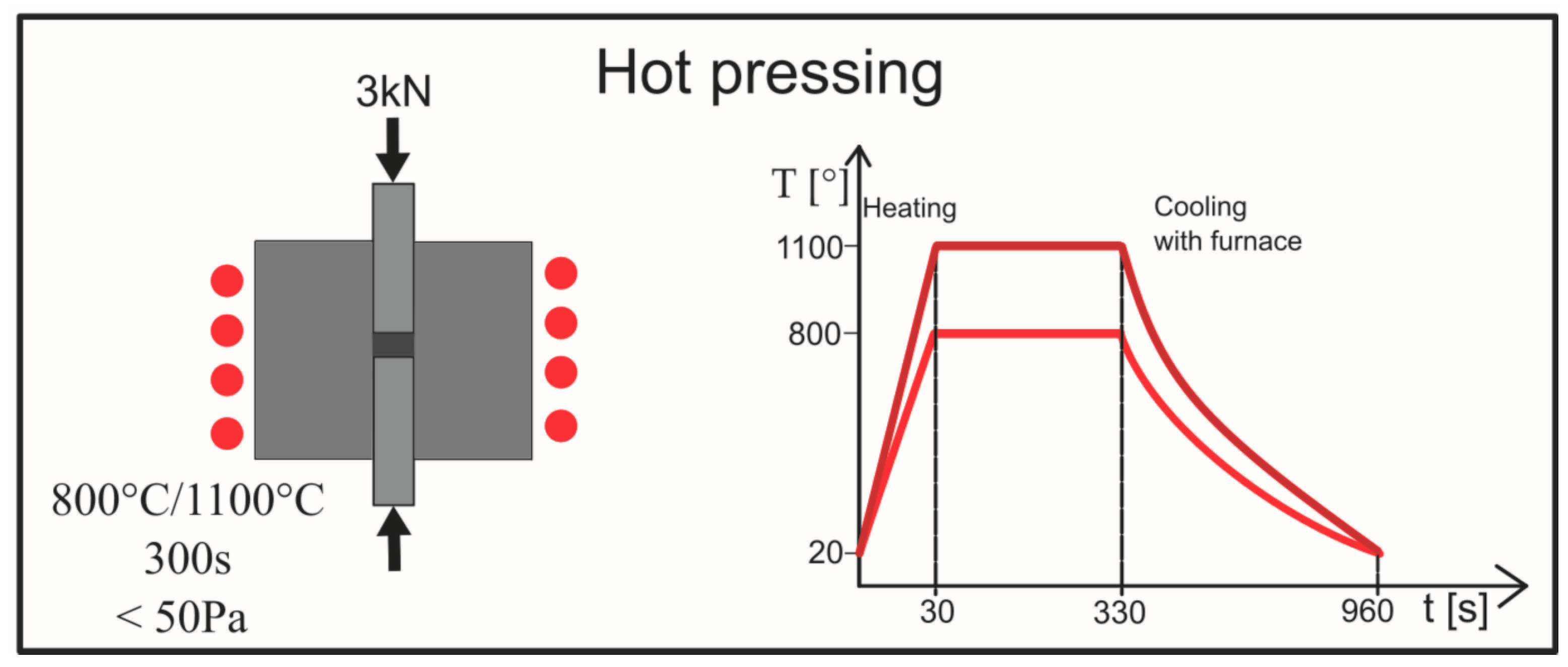

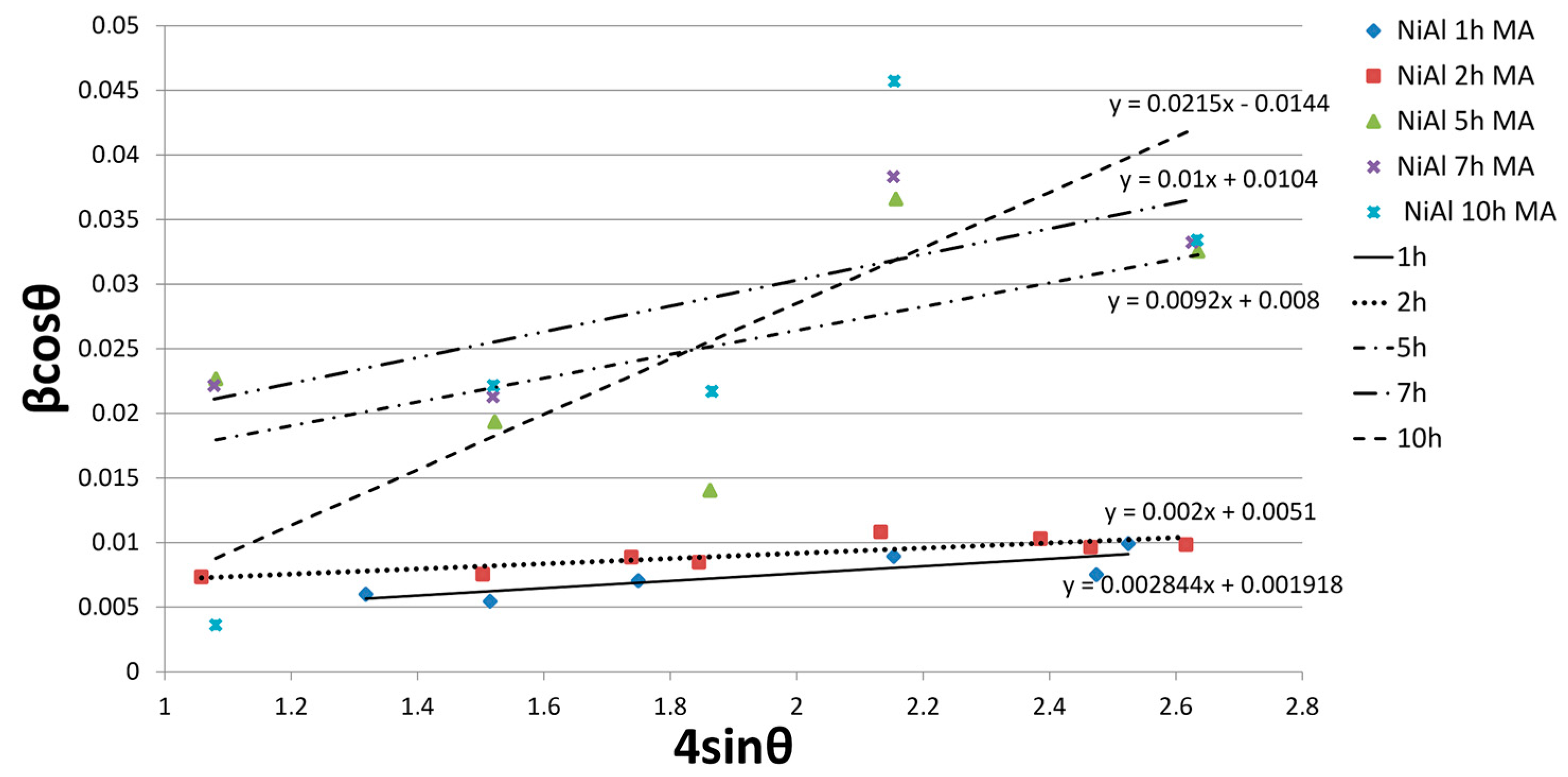

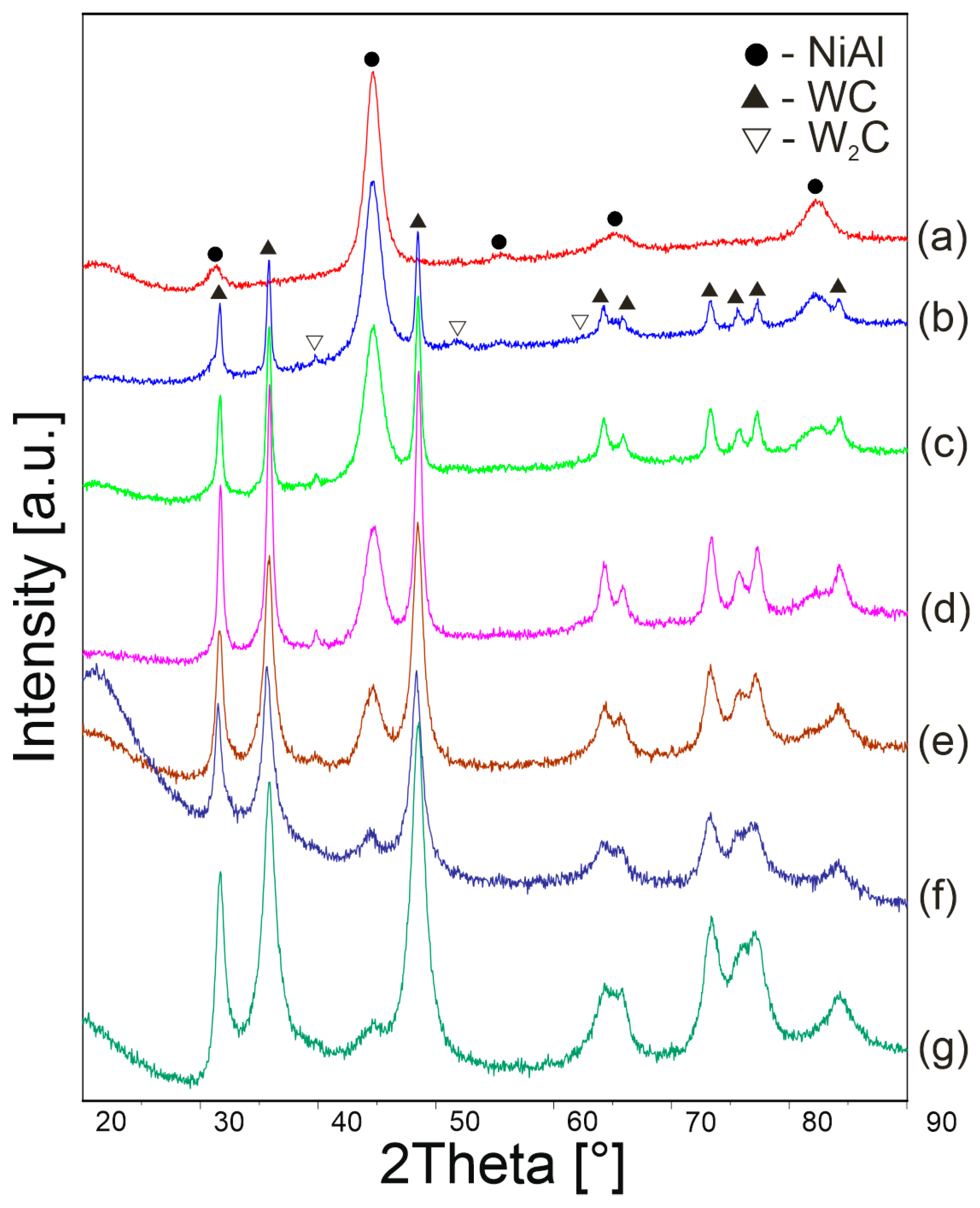
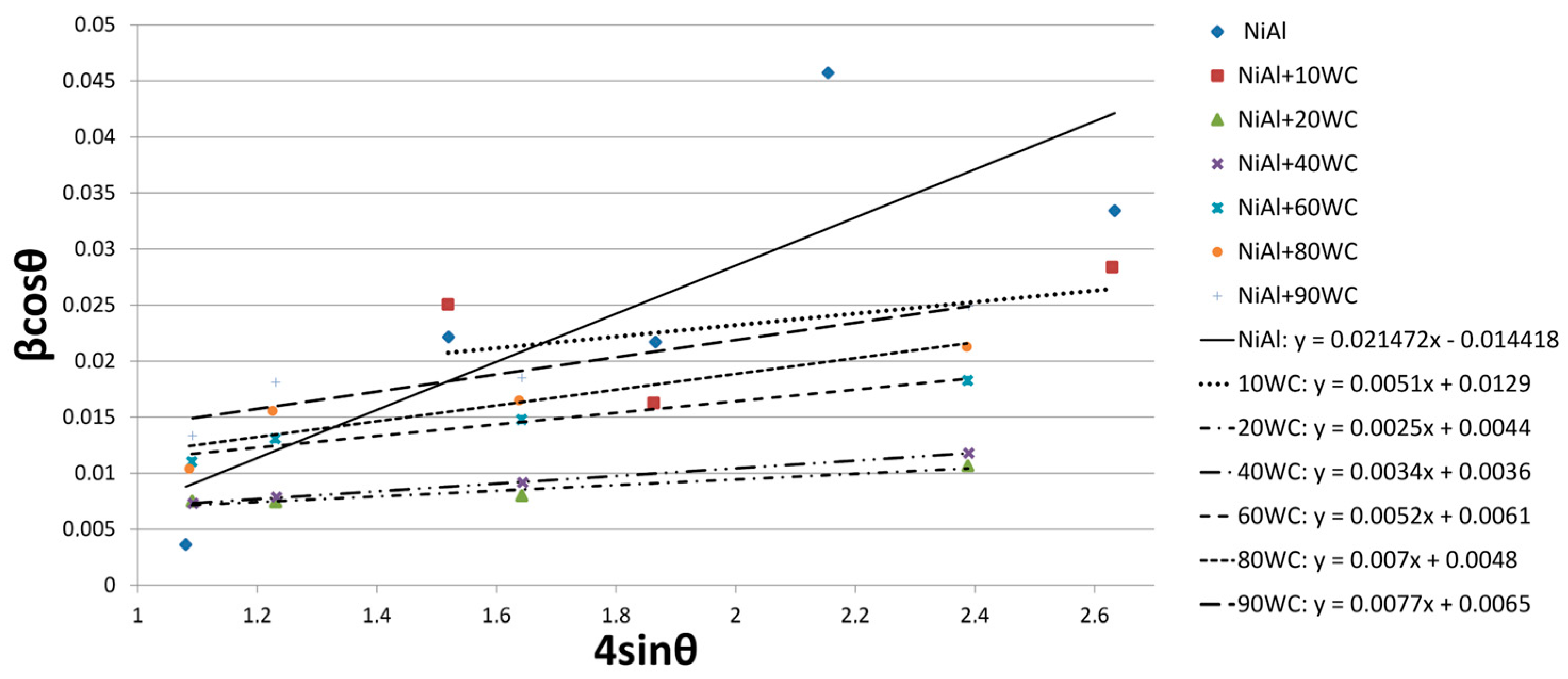
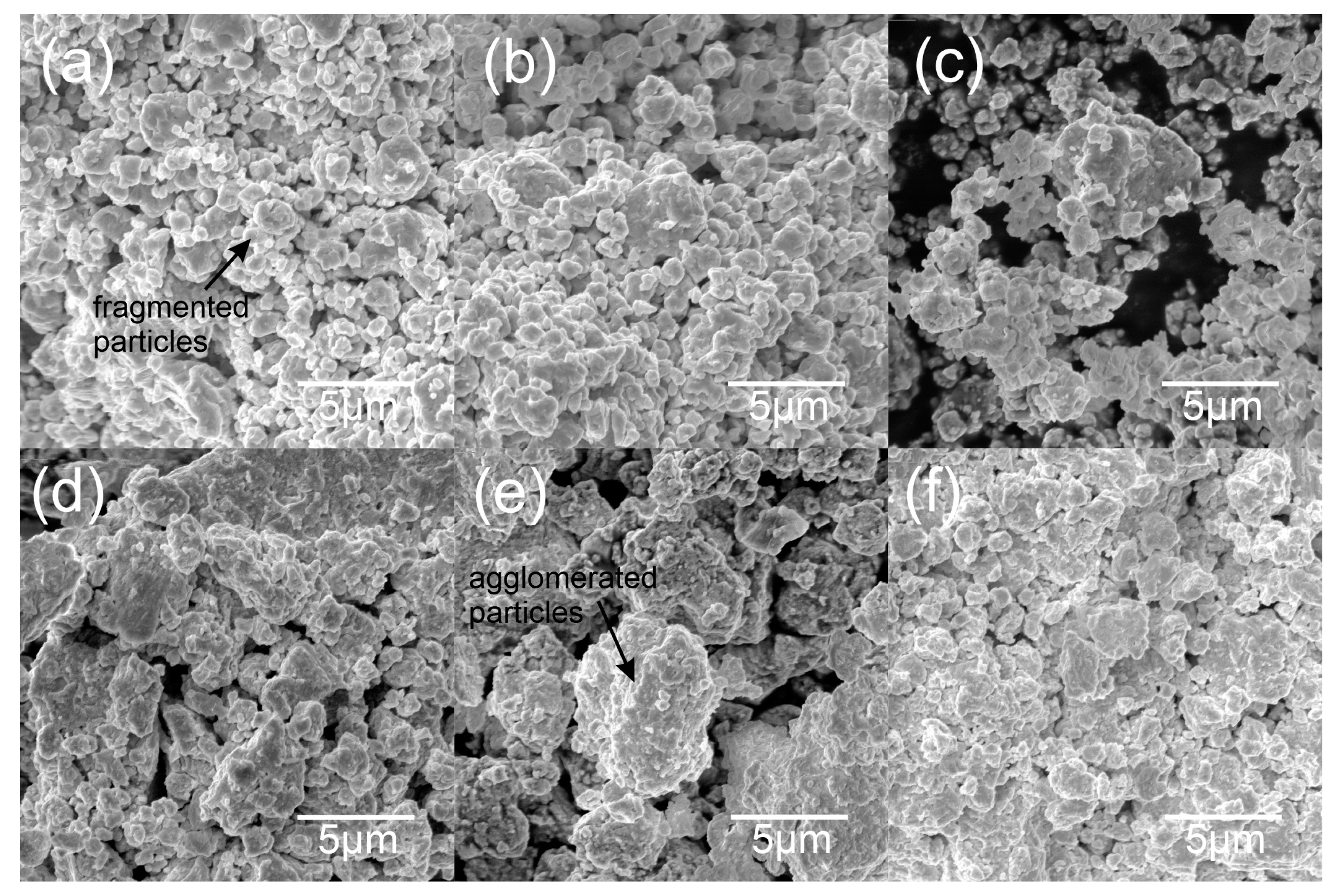
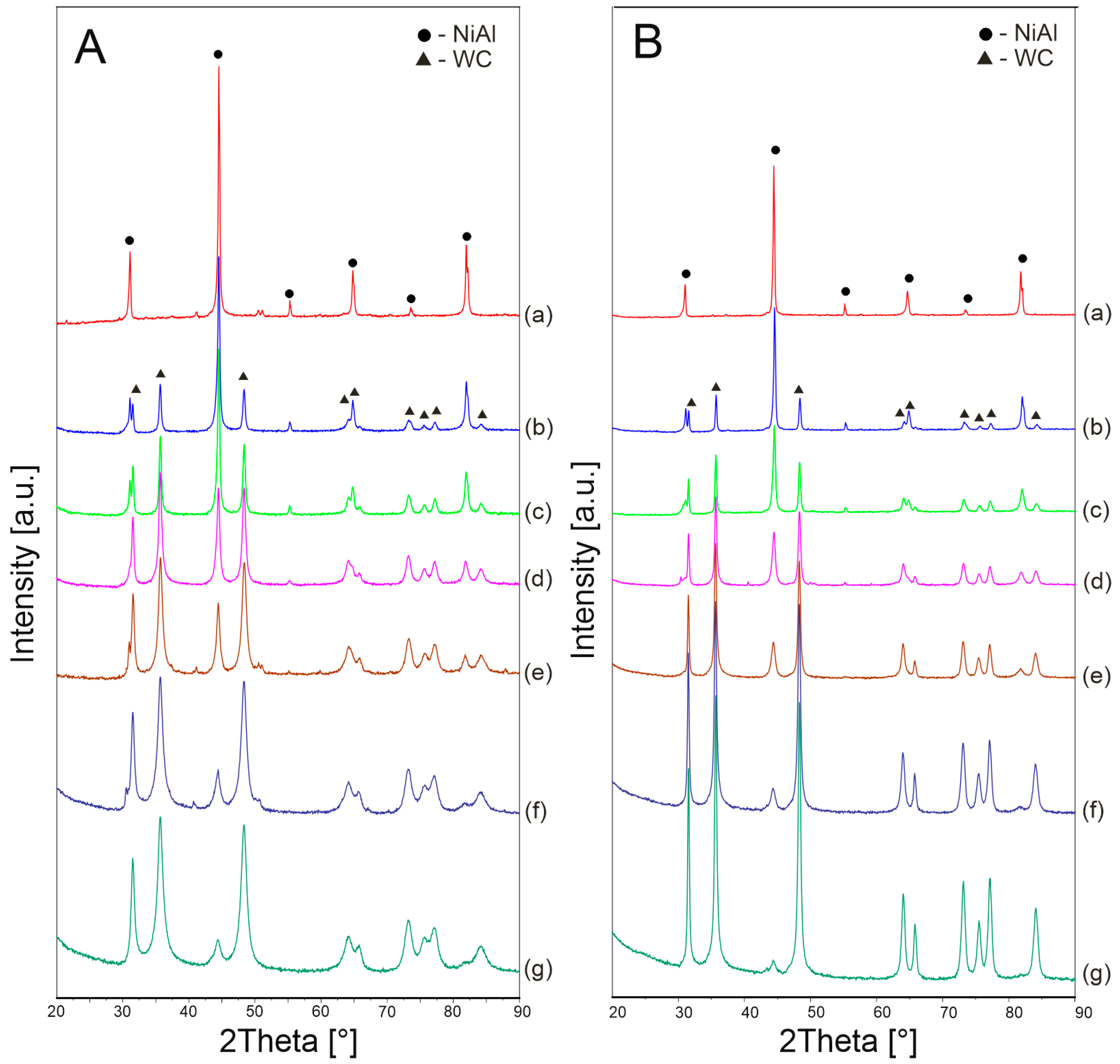
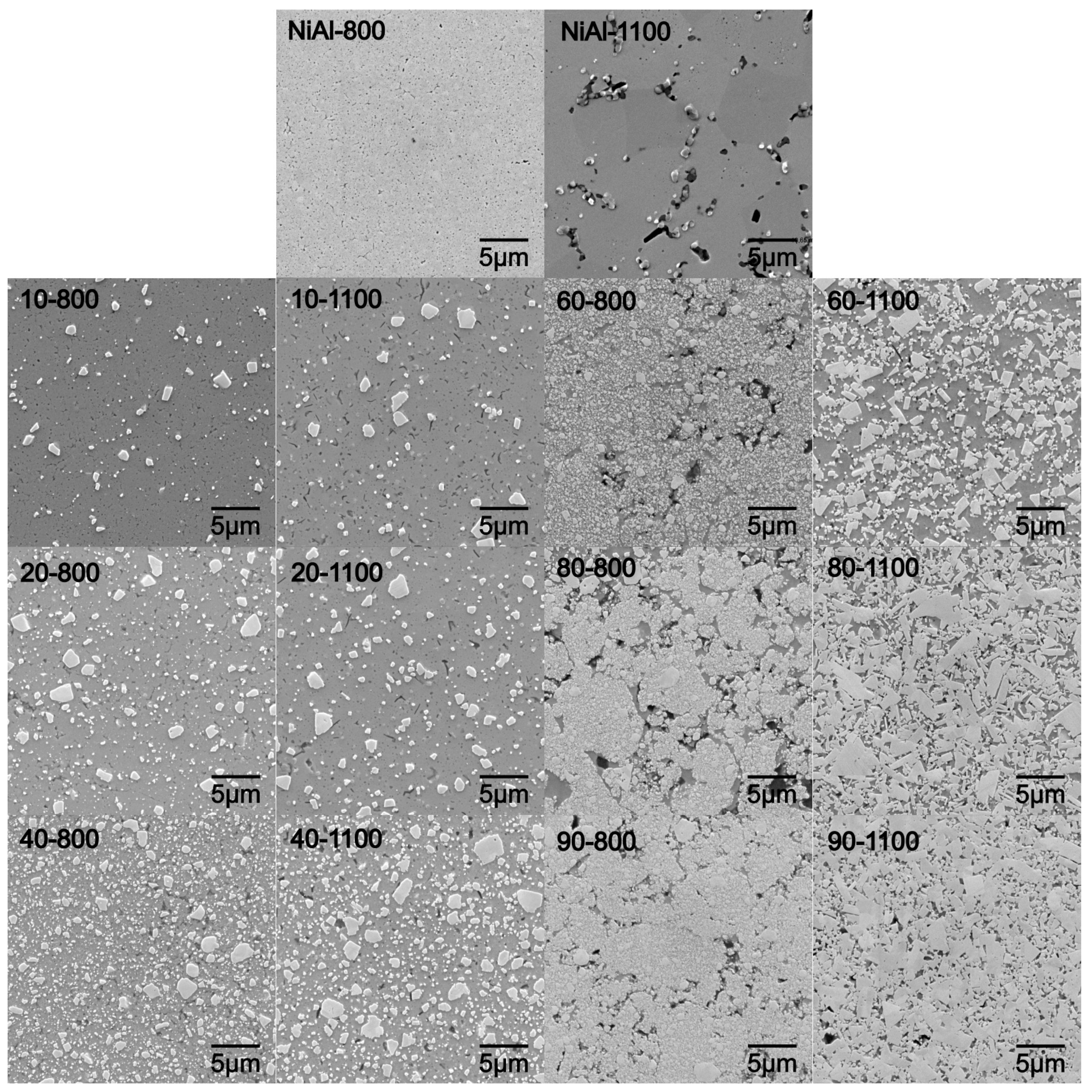

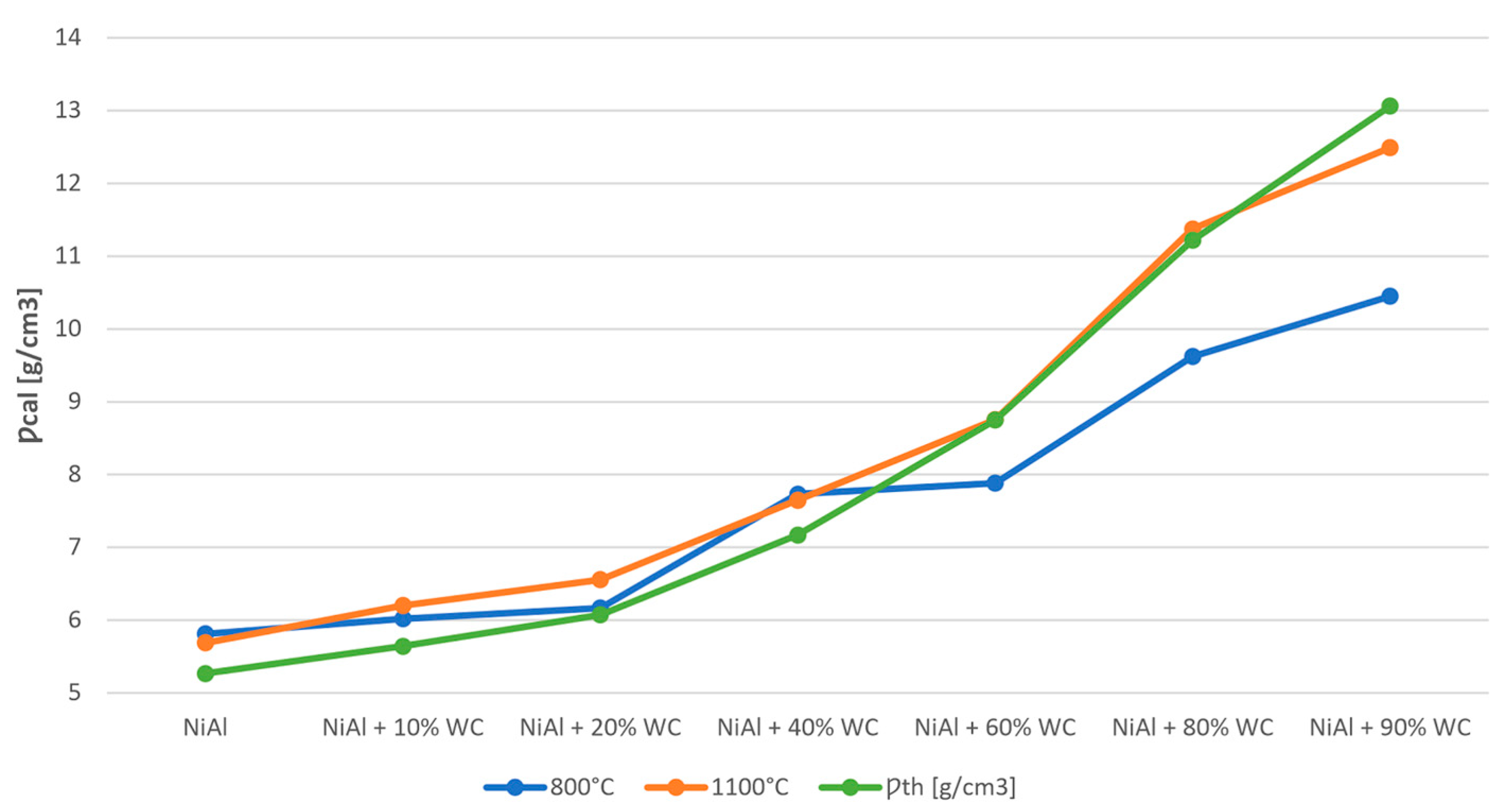
| Sample | Sintering Temperature [°C] | Symbol |
|---|---|---|
| NiAl | 800 | NiAl-800 |
| NiAl + 10% WC | 10–800 | |
| NiAl + 20% WC | 20–800 | |
| NiAl + 40% WC | 40–800 | |
| NiAl + 60% WC | 60–800 | |
| NiAl + 80% WC | 80–800 | |
| NiAl + 90% WC | 90–800 | |
| NiAl | 1100 | NiAl-1100 |
| NiAl + 10% WC | 10–1100 | |
| NiAl + 20% WC | 20–1100 | |
| NiAl + 40% WC | 40–1100 | |
| NiAl + 60% WC | 60–1100 | |
| NiAl + 80% WC | 80–1100 | |
| NiAl + 90% WC | 90–1100 |
| NiAl Milling Time | ε | D [nm] |
|---|---|---|
| 1 h | 0.002844 | 72 |
| 2 h | 0.002012 | 27 |
| 5 h | 0.009218 | 17 |
| 7 h | 0.009970 | 13 |
| 10 h | 0.021500 | 10 |
| Powder Composition | ε | D [nm] |
|---|---|---|
| NiAl + 10% WC | 0.0051 | 28 |
| NiAl + 20% WC | 0.0025 | 32 |
| NiAl + 40% WC | 0.0034 | 39 |
| NiAl + 60% WC | 0.0052 | 23 |
| NiAl + 80% WC | 0.0070 | 29 |
| NiAl + 90% WC | 0.0077 | 21 |
| Powder Composition | Average Powder Particle Size [µm] | Standard Deviation [µm] |
|---|---|---|
| Al | 21.85 | 13.16 |
| Ni | 0.64 | 0.34 |
| WC | 3.17 | 1.13 |
| NiAl | 2.05 | 0.83 |
| NiAl + 10% WC | 1.13 | 0.68 |
| NiAl + 20% WC | 1.45 | 0.63 |
| NiAl + 40% WC | 1.76 | 0.99 |
| NiAl + 60% WC | 2.29 | 0.96 |
| NiAl + 80% WC | 3.10 | 1.83 |
| NiAl + 90% WC | 1.75 | 0.63 |
| Sample | NiAl | WC | Rwp [%] | Rexp [%] | GOF | Planimetric NiAl Content [%] | |||||
|---|---|---|---|---|---|---|---|---|---|---|---|
| a [Å] | V [Å] | PA [%] | a [Å] | c [Å] | V [Å] | PA [%] | |||||
| NiAl-800 | 2.877748 | 23.83189 | 100 | - | - | - | - | 2.79074 | 1.26216 | 3.45235 | - |
| NiAl-1100 | 2.881795 | 23.93257 | 100 | - | - | - | - | 3.52871 | 1.53387 | 4.15852 | - |
| 10–800 | 2.877455 | 23.82459 | 91.4 | 2.905589 | 2.837235 | 20.74408 | 8.6 | 3.88914 | 1.64960 | 3.72663 | - |
| 10–1100 | 2.876814 | 23.80868 | 94.0 | 2.904611 | 2.836464 | 20.72449 | 6.0 | 3.20058 | 1.66355 | 2.99967 | 90.2 |
| 20–800 | 2.878794 | 23.85789 | 82.0 | 2.905391 | 2.835926 | 20.73169 | 18.0 | 3.04924 | 1.72062 | 2.80676 | - |
| 20–1100 | 2.879063 | 23.86455 | 82.5 | 2.906711 | 2.836687 | 20.75611 | 17.5 | 3.80800 | 1.69231 | 3.69920 | 82.0 |
| 40–800 | 2.883199 | 23.96756 | 59.7 | 2.907169 | 2.837852 | 20.77116 | 40.3 | 3.78441 | 1.89541 | 2.88086 | - |
| 40–1100 | 2.885629 | 24.02822 | 59.5 | 2.910031 | 2.839636 | 20.82517 | 40.5 | 3.87954 | 1.92495 | 3.08873 | 65.1 |
| 60–800 | 2.884665 | 24.00413 | 42.9 | 2.905388 | 2.836926 | 20.73895 | 57.1 | 4.58649 | 2.15801 | 2.76792 | - |
| 60–1100 | 2.889674 | 24.12940 | 35.9 | 2.911327 | 2.839604 | 20.84349 | 64.1 | 4.94694 | 2.24004 | 3.37547 | 53.3 |
| 80–800 | - | - | - | - | - | - | - | - | - | - | - |
| 80–1100 | 2.891775 | 24.18207 | 14.3 | 2.911662 | 2.839584 | 20.84814 | 85.7 | 6.816 | 2.69761 | 3.23206 | 22.5 |
| 90–800 | - | - | - | - | - | - | - | - | - | - | - |
| 90–1100 | 2.890064 | 24.13917 | 13.2 | 2.910384 | 2.839364 | 20.82823 | 86.8 | 7.65265 | 2.73152 | 3.37985 | 11.7 |
| Ref. WC | - | - | - | 2.9063 | 2.8375 | 20.76 | - | - | - | - | - |
| Ref. NiAl | 2.8855 | 24.02 | - | - | - | - | - | - | - | - | - |
| NiAl | NiAl + 10WC | NiAl + 20WC | NiAl + 40WC | NiAl + 60WC | NiAl + 80WC | NiAl + 90WC | ||
|---|---|---|---|---|---|---|---|---|
| 800 °C | HV | 652 ± 5 | 792 ± 21 | 797 ± 41 | 799 ± 59 | 967 ± 63 | 1218 ± 237 | 953 ± 93 |
| Ƿcal [g/cm3] | 5.81 | 6.02 | 6.17 | 7.73 | 7.88 | 9.62 | 10.45 | |
| 1100 °C | HV | 409 ± 4 | 542 ± 11 | 603 ± 16 | 736 ± 59 | 912 ± 63 | 1539 ± 93 | 1800 ± 79 |
| Ƿcal [g/cm3] | 5.69 | 6.20 | 6.56 | 7.65 | 8.75 | 11.37 | 12.49 | |
| Ƿth [g/cm3] | 5.27 | 5.64 | 6.08 | 7.17 | 8.75 | 11.22 | 13.06 | |
Disclaimer/Publisher’s Note: The statements, opinions and data contained in all publications are solely those of the individual author(s) and contributor(s) and not of MDPI and/or the editor(s). MDPI and/or the editor(s) disclaim responsibility for any injury to people or property resulting from any ideas, methods, instructions or products referred to in the content. |
© 2023 by the authors. Licensee MDPI, Basel, Switzerland. This article is an open access article distributed under the terms and conditions of the Creative Commons Attribution (CC BY) license (https://creativecommons.org/licenses/by/4.0/).
Share and Cite
Piechowiak, D.; Kania, A.; Łukaszkiewicz, N.; Miklaszewski, A. Properties and Microstructure Evaluation in NiAl-xWC (x = 0 − 90 wt.%) Intermetallic-Based Composites Prepared by Mechanical Alloying. Materials 2023, 16, 2048. https://doi.org/10.3390/ma16052048
Piechowiak D, Kania A, Łukaszkiewicz N, Miklaszewski A. Properties and Microstructure Evaluation in NiAl-xWC (x = 0 − 90 wt.%) Intermetallic-Based Composites Prepared by Mechanical Alloying. Materials. 2023; 16(5):2048. https://doi.org/10.3390/ma16052048
Chicago/Turabian StylePiechowiak, Daria, Albert Kania, Natalia Łukaszkiewicz, and Andrzej Miklaszewski. 2023. "Properties and Microstructure Evaluation in NiAl-xWC (x = 0 − 90 wt.%) Intermetallic-Based Composites Prepared by Mechanical Alloying" Materials 16, no. 5: 2048. https://doi.org/10.3390/ma16052048







